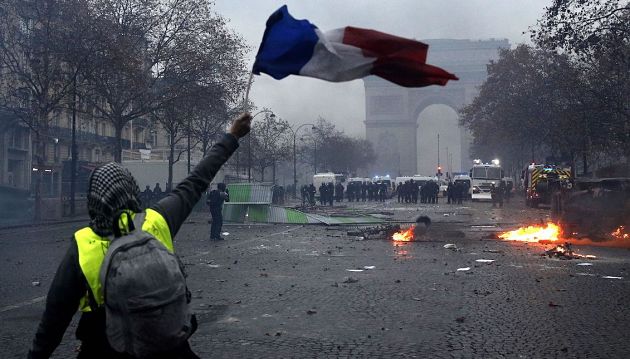In recent weeks, the French people, whatever their views on their history and values, have once again demonstrated that they remain united and capable of fighting for the interests of their nation, which the authorities cannot simply dismiss.
Beginning in the middle of last month, this seemingly prosperous and polished country rose up and gave birth to mass and highly radical protests against the anti-populist policies of the government. The protests were sparked by the government’s plans to raise fuel taxes in the new year, which would increase the price of gasoline by 2.9 cents per liter and diesel by 6.5 cents. This is despite the fact that gasoline prices have already risen by 15% and diesel prices by 23% this year.
The result was a spontaneous protest of yellow vests, the emergency vests that drivers must wear on the road when their car stops moving. In total, about 150,000 people across the country participated in these protests, which culminated in mass disorder and clashes with police in the center of Paris. As a result, the French government, condemning the “extremists,” was forced to announce a postponement of its plans for at least six months.
Whether it will decide to implement them later remains unclear, as President Emmanuel Macron’s popularity rating is currently one of the lowest of any incumbent. And to be re-elected, unlike in Russia, he will have to win in fair and competitive elections. Which will be extremely problematic if mass protests and unrest continue throughout the country.
In other words, the French have shown how people should behave toward the government in order for it to take into account the moods and needs of the people it leads. It is clear that this requires an appropriate system, because if people took to the streets of Beijing or Cairo with such protests, they would simply be crushed by tank tracks.
On the other hand, for such a political system to exist, the people must also be adequate. During the last mass protests against the Putin regime in Russia in 2011-2012, more Russians took to the streets than the number of French people protesting now. And no one ran them over with tanks – the authorities tried to neutralize them carefully, and only resorted to repression and tightening the screws after they were sure the protests had subsided. Perhaps because the Russian demonstrators waved balloons and left. The French did not leave without achieving their goal, and they waved more than balloons. Hence the result.

